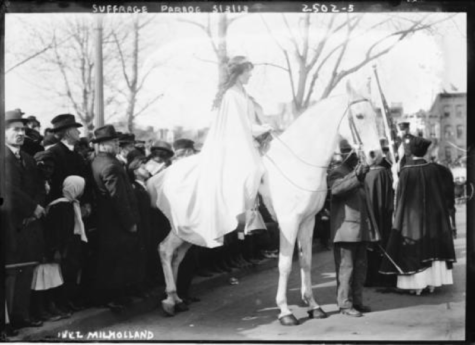19th Amendment celebrates 97th anniversary
August 18, 2017

Just over 97 years ago, the country that claims “liberty and justice for all” denied half its population the right to vote.
This statement is in reference to American women who had to fight for their right to vote until the ratification of the 19th constitutional amendment in 1920 – 144 years after the United States was created. The amendment was ratified after over 70 years of marches, conventions, and pickets supporting women’s rights, led by activists such as Susan B. Anthony, Alice Paul, and Elizabeth Cady Stanton.
The women’s rights movement, although present throughout a large part of history, took off in the 1820s and 30s. At the time, anti-slavery groups were formed, many involving women. These women, alongside other activists and abolitionists, helped push for the abolishment of slavery in America and the ratification of the 15th amendment, which states that the right to vote shall not be denied to anyone based on race. However, some women opposed the 15th amendment because it still did not allow women to vote.
Although the 15th amendment was a step in the right direction, women were still denied suffrage. A focus shifted onto women’s rights in 1848 with the formation of the Seneca Falls Convention. The convention was organized by Lucretia Mott and Stanton and took place on July 19 and 20 at the Wesleyan Chapel.
The first day was open strictly to women with 200 in attendance, but the second day was open to men with 40 showing up. Among the men was Frederick Douglass, a famous abolitionist. The main event was Stanton’s reading of the Declaration of Sentiments and Grievances, a document based off the Declaration of Independence that demands rights be given to women. By the end of the convention, 68 women and 32 men voiced their approval of the declaration.
Shortly after the convention, Stanton and Anthony formed the National Woman Suffrage Association in 1869. The goal of the NWSA was to create a constitutional amendment that allowed women to vote. At the same time, Lucy Stone and Henry Stonewell created the American Woman Suffrage Association with a similar goal in mind as the NWSA. Despite their differences, both organizations celebrated when the territory of Wyoming allowed all women over the age of 21 to vote in 1869.
The NWSA and AWSA finally merged to form one unified women’s suffrage organization called the National American Woman Suffrage Association (NAWSA) in 1890. Stanton was the organization’s first president and helped shape its new goal of promoting voting rights for women, but now on a state-to-state level. The group’s efforts led to the legalization of women’s suffrage in Colorado, Utah, and Idaho in a span of six years.
The inauguration of President Woodrow Wilson in March of 1913 brought forth a new wave of women’s suffrage efforts, led by the likes of Lucy Burns and Alice Paul. This wave of women and their supporters started to use bolder and more public methods to relay their message of universal suffrage. The first of these methods was demonstrated by a parade through Washington, D.C. on the eve of President Wilson’s inauguration.
The parade, known officially as the Woman Suffrage Procession, was physically led and partially organized by Inez Milholland, a labor lawyer from New York. The idea for the procession was created by Burns and Paul who submitted a proposal for the event to NAWSA leaders in 1912. NAWSA rejected the idea at first because they did not want to stray from their typical state-to-state approach. However, after gaining the support of Jane Addams, a well-known social activist, Burns and Paul were able to convince NAWSA to endorse the procession.
The procession was made up of about 8,000 people, mostly women, from all over the United States, as well as other countries such as India, Canada, and New Zealand. Nine bands, four mounted brigades, and 20 floats accompanied the marchers down Pennsylvania Avenue. Ahead of them marched Milholland on horseback, dressed in a white cape and crown.
Burns and Paul chose to hold the procession right before President Wilson’s inauguration because of his well-known opposition to women’s suffrage or any pro-women movement for that matter. The procession, along with the many future protests, was held in hopes of changing Wilson’s opinion and gaining his support. Five years later, Wilson changed his stance on women’s suffrage and voiced his support for the movement.
However, the march wasn’t accepted by everyone, despite drawing crowds of onlookers and observers. The procession was faced with adversity from outside groups, as well as people within NAWSA. During the planning process, there was a debate about whether or not black women would be allowed to march. Southern women didn’t want them to march at all, while others had no problem with marching alongside women of color. It is unknown whether organizers made a definitive decision to segregate or not, but either way, black women did end up participating in the procession.
During the procession itself, groups of men stood in the women’s path, despite the suffragettes having gotten permission for the roads to be blocked off specifically for the march. The men physically assaulted the women while the police did little or nothing to help them. Eventually, other men created a human barrier between the march and angry onlookers, however, over 200 women were treated for injuries as a result of the physical abuse they encountered while peacefully protesting.
May 21, 1919 marked the start of substantial progress towards the ratification of the 19th amendment. On that day, Representative James Mann proposed to the House approval of the amendment created by Susan Anthony. The amendment passed through the House with votes well above the two-thirds majority requirement. The amendment was passed by the Senate two weeks later, 56-25, and then immediately sent to the states for ratification.
In a short amount of time, six states ratified the amendment; these states included Illinois, Ohio, Michigan, Wisconsin, Ohio, Kansas, and New York. Almost a year later, the amendment was ratified by 35 states, one state short of the required majority. Because all the other southern states almost immediately rejected the proposed amendment, it came down to Tennessee.
The decision in Tennessee was close with the state’s legislature tied 48-48. The fate of women’s suffrage fell into the hands of Republican Representative Harry Burn. Originally, Burn was against the idea of women’s suffrage, but his mother convinced him otherwise. Thanks to her, Burn voted yes, and the 19th amendment was officially part of the Constitution. However, it took several years for the remaining states to officially ratify the amendment themselves. Mississippi was the last, not ratifying it until March 22, 1984.
Although the fight for women’s suffrage in the United States is in the past, many elements from the long and hard battle are still seen today. American women today are now fighting for more rights that would put them equal to men and are doing so through methods similar to those of the suffragettes.
For example, around 500,000 women participated in the Women’s March on January 21, 2017 in Washington, D.C. The march’s endpoint was the White House, where President Donald Trump was newly inaugurated. This peaceful protest was incredibly similar to the Woman Suffrage Procession that covered the same ground over 100 years ago.
No matter how many years have passed since the fight for women’s suffrage and the amendment it produced, the ideas and examples presented still resonate today and will continue to resonate until all women are provided with the same rights and freedoms as men.






